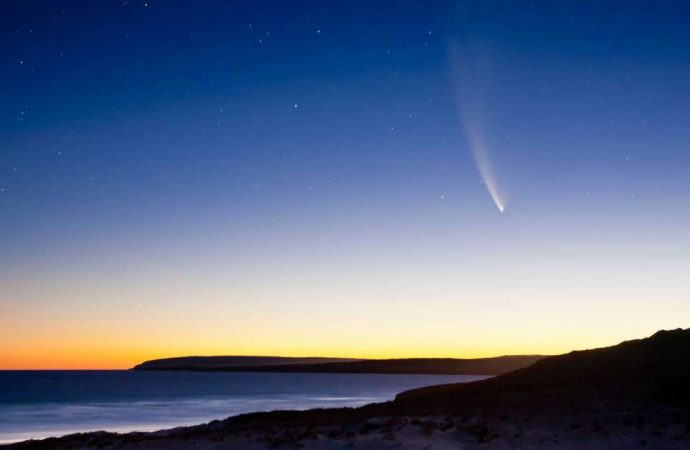A comet named C/2020 is expected to be visible from Earth at various points throughout July.
Source: Travel and Leisure
Skywatchers are in for a surprise treat this month thanks to a comet very few people saw coming.
On March 27, astronomers first observed a dim little comet flying by our planet using NEOWISE, or Near-Earth Object Wide-field Infrared Survey Explorer, a space telescope launched by NASA more than a decade ago, EarthSky explained. The astronomers cataloged the comet as C/2020 and didn’t think much of it at the time as it was nowhere near bright enough to be visible to the naked eye. But, after surviving a flyby approach to the sun, it seems as though the comet is boomeranging back toward Earth and is already bright enough in the sky to be viewed with the assistance of simple binoculars.
“Hot off the presses! Caught my first glimpse of Comet NEOWISE (C/2020 F3) from Bloomington, Indiana early this morning, just as it was rising above the trees and dawn was beginning,” astrophotographer Zolt Levay wrote on Facebook alongside his images. “Still not a super spectacular comet, but with a bright nucleus and prominent tail. And so far it’s much better than the last two comets that were predicted to be knockouts.”
Truly, C/2020 is surprising just about everyone in the astronomy world. Comet expert John E. Bortle of Stormville, New York told Space.com he’s “amazed” at the comet’s performance.

“Theoretically, the comet shouldn’t still be brightening noticeably, as its distance to the sun is undergoing only a small reduction day-to-day at this point, making me think that the comet’s current brightness is not being governed mainly by its distance from the sun but, rather it is experiencing some manner of progressive slow outburst,” he shared.
Even the astronauts aboard the International Space Station were excited to spot the comet as it flew by. On Saturday, Russian astronaut Ivan Vagner tweeted a few images he took outside his celestial window.
“During the next revolution I tried to capture the C/2020 F3 (NEOWISE) comet a bit closer, the brightest one over the last 7 years,” he wrote. “Its tail is quite clearly visible from the @Space_Station!”
According to Space.com, the comet could become even more visible in the evening sky starting on July 12. That is when it will appear low in the northwest sky and will continue to climb even higher in the following days. On July 22, the comet will make its closest approach to Earth for another excellent viewing opportunity. On July 25, the comet will appear some 30 degrees up from the west-northwest horizon just after the sun sets, creating the potential for excellent comet spotting.
If you have any interest in seeing the comet now really is the time to make an effort. According to EarthSky, C/2020 might not be visible from Earth again until the year 8,786.
Source: Travel and Leisure

































Leave a Comment
You must be logged in to post a comment.